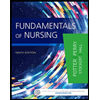
To discuss:
How and why would the nurse respond to this situation.
Case summary:
Ms. A is a 49-year-old female patient who is an attorney and recently suffered from a major cerebral hemorrhage. As a lawyer, she had an advanced directive prepared that states that she should not give life-support when she is in comatose. According to the physicians and nurses, there is no sign of improvement in the patient. On the contrary, one neurosurgeon suggests that there are some signs of improvement in the patient. The patient’s family arrives and has a two-point of discussion.
Explanation of Solution
As a student nurse, she responds to the situations like talking with the social worker that the patient is already stated that she do not want life support when she is in comatose in her advance directive. The student nurse asks the social worker that why the patient directive was not followed and she personally believes that the patient’s directive should be followed.
To discuss:
The factors that affect the student nurse’s response and explain the factors with possible effect.
Case summary:
Ms. A is a 49-year-old female patient who is an attorney and recently suffered from a major cerebral hemorrhage. As a lawyer, she had an advanced directive prepared that states that she should not give life-support when she is in comatose. According to the physicians and nurses, there is no sign of improvement in the patient. On the contrary, one neurosurgeon suggests that there are some signs of improvement in the patient. The patient’s family arrives and has a two-point of discussion.
Explanation of Solution
The student nurse asks the social worker, why the patient’s directive is not implied when it is stated in the patient’s advanced directive. The social worker explains that the directive may imply ethical issues regarding the removal of life-support from the patient, when one neurosurgeon implies an improvement of the patient in comatose.
To discuss:
Whether the criteria of the student nurse is used to evaluate successful outcome.
Case summary:
Ms. A is a 49-year-old female patient who is an attorney and recently suffered from a major cerebral hemorrhage. As a lawyer, she had an advanced directive prepared that states that she should not give life-support when she is in comatose. According to the physicians and nurses, there is no sign of improvement in the patient. On the contrary, one neurosurgeon suggests that there are some signs of improvement in the patient. The patient’s family arrives and has a two-point of discussion.
Explanation of Solution
The successful outcome of withdrawal of life support by the student nurse is a critical to assess, as there are ethical issues regarding the comatose patient. Though her directive may reveal that life support should be withdrawn, but the statement of the neurosurgeon on improvement in the patient gives a little hope of recovery.
To discuss:
The knowledge, skills, and attitudes do you need to develop to continuously improve quality and safety when caring for child patients like Ms. A.
Case summary:
Ms. A is a 49-year-old female patient who is an attorney and recently suffered from a major cerebral hemorrhage. As a lawyer, she had an advanced directive prepared that states that she should not give life-support when she is in comatose. According to the physicians and nurses, there is no sign of improvement in the patient. On the contrary, one neurosurgeon suggests that there are some signs of improvement in the patient. The patient’s family arrives and has a two-point of discussion.
Explanation of Solution
- The advance directive should have more explanation for the comatose patient.
- The ethical and legal issues should be based on the logical explanations.
- The attorney must have the right to implement further treatment if there are any chances of improvement in the patient.
To discuss:
If the professional integrity is affirmed.
Case summary:
Ms. A is a 49-year-old female patient who is an attorney and recently suffered from a major cerebral hemorrhage. As a lawyer, she had an advanced directive prepared that states that she should not give life-support when she is in comatose. According to the physicians and nurses, there is no sign of improvement in the patient. On the contrary, one neurosurgeon suggests that there are some signs of improvement in the patient. The patient’s family arrives and has a two-point of discussion.
Explanation of Solution
The professional integrity of the student nurse is of course affirmed, as the student nurse did not take any actions regarding to the will of the patient or go against the neurosurgeon’s decision. The student nurse is getting more learned by expressing her suggestion to the social worker.
Want to see more full solutions like this?
- explain an abdominal exam?arrow_forwardDiscuss β -Lactam antibiotics under the following subheadings Classifications of penicillins Classification of Cephalosporins General Mechanism of Actions Clinical Indications of penicillins and cephalosporins Adverse effects of β-lactamsarrow_forwarda. Define neoplasm b. Differentiate between benign and malignant tumours c. Describe the molecular basis of cancerarrow_forward
- differentiate the extra heart sounds S3,S4, murmurs and gallopsarrow_forward• Define shock and list types of shock • Discuss pathogenesis of septic shock. • Enumerate the stages of shock. • Define oedema and describe the pathophysiologic mechanisms of oedema with examples.arrow_forwardDiscuss Hypertension under the following headings: Definition Diagnosis Non-pharmacological intervention Drugs Classification Management of a Hypertensive emergencyarrow_forward
- Explain how the answer could be 2 or 1.8 WITHOUT changing the questionarrow_forwardoverview of the neurological system, cranial nerves and what part of the body it innervatesarrow_forwarddifferentiate structure and function of the peripheral vascular system. what are the normal and abnormal findings of the peripheral arterioles and peripheral venous systemarrow_forward
 Phlebotomy EssentialsNursingISBN:9781451194524Author:Ruth McCall, Cathee M. Tankersley MT(ASCP)Publisher:JONES+BARTLETT PUBLISHERS, INC.
Phlebotomy EssentialsNursingISBN:9781451194524Author:Ruth McCall, Cathee M. Tankersley MT(ASCP)Publisher:JONES+BARTLETT PUBLISHERS, INC. Gould's Pathophysiology for the Health Profession...NursingISBN:9780323414425Author:Robert J Hubert BSPublisher:Saunders
Gould's Pathophysiology for the Health Profession...NursingISBN:9780323414425Author:Robert J Hubert BSPublisher:Saunders Fundamentals Of NursingNursingISBN:9781496362179Author:Taylor, Carol (carol R.), LYNN, Pamela (pamela Barbara), Bartlett, Jennifer L.Publisher:Wolters Kluwer,
Fundamentals Of NursingNursingISBN:9781496362179Author:Taylor, Carol (carol R.), LYNN, Pamela (pamela Barbara), Bartlett, Jennifer L.Publisher:Wolters Kluwer, Fundamentals of Nursing, 9eNursingISBN:9780323327404Author:Patricia A. Potter RN MSN PhD FAAN, Anne Griffin Perry RN EdD FAAN, Patricia Stockert RN BSN MS PhD, Amy Hall RN BSN MS PhD CNEPublisher:Elsevier Science
Fundamentals of Nursing, 9eNursingISBN:9780323327404Author:Patricia A. Potter RN MSN PhD FAAN, Anne Griffin Perry RN EdD FAAN, Patricia Stockert RN BSN MS PhD, Amy Hall RN BSN MS PhD CNEPublisher:Elsevier Science Study Guide for Gould's Pathophysiology for the H...NursingISBN:9780323414142Author:Hubert BS, Robert J; VanMeter PhD, Karin C.Publisher:Saunders
Study Guide for Gould's Pathophysiology for the H...NursingISBN:9780323414142Author:Hubert BS, Robert J; VanMeter PhD, Karin C.Publisher:Saunders Issues and Ethics in the Helping Professions (Min...NursingISBN:9781337406291Author:Gerald Corey, Marianne Schneider Corey, Cindy CoreyPublisher:Cengage Learning
Issues and Ethics in the Helping Professions (Min...NursingISBN:9781337406291Author:Gerald Corey, Marianne Schneider Corey, Cindy CoreyPublisher:Cengage Learning





